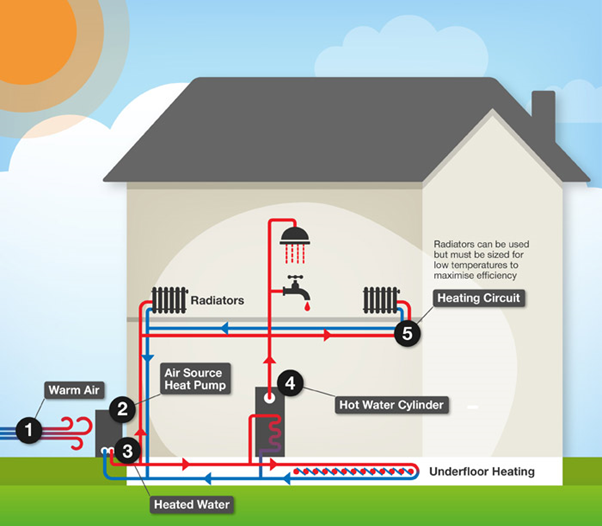Air to water heat pumps
This type of heat pump extracts heat from the outside air. The transport medium for heat inside the dwelling is water, hence the name ‘air-to-water heat pump’.
Figure 1 illustrates the configurations for this type of heat pump.

-
Air is drawn into the heat pump from the outside air.
-
The heat pump absorbs the heat from the air and transfers this heat via a refrigerant to the water system in the building, providing heating and hot tap water.
-
The heated water from the heat pump is circulated around the heating circuit and indirectly passed through a hot water cylinder via a coil, just as it would be with a traditional boiler system. A complementary option could be an integrated or separated (electric) boiler for additional hot tap water usage.
-
Hot water is stored within this cylinder and is available as hot tap water.
-
The heated water from the heat pump radiates heat through either radiators or more suitably through under floor heating and is then circulated back through the pump to be reheated.
A heating device must, among other things, be selected for its heating capacity. This capacity depends on (1) the degree of insulation of a building, (2) the desired interior temperature and (3) the size of the building. The largest houses are larger than the smallest buildings within the utility sector (and the other way around). This means that every heat pump that is placed in the residential sector can also be found within the services sector. Within the latter sector however, there are also much larger buildings; this does create a different situation with a much larger heat demand. Such buildings are often equipped with several heating appliances, which are placed in a cascade arrangement. When the outside temperature drops further, an additional appliance will start operating. This way, electrical heat pumps are most often combined with gas-fired boilers. The more efficient, but more expensive heat pump, for example, provides 80% of the heat demand, the gas boiler only assists on the coldest days in order to meet the ‘peak heat demand’. The combination of an electric heat pumps with a gas-fired boiler can be considered as a ‘hybrid cascade setup’. In a services building that reaches the level of ‘nearly zero energy’, a stand-alone heat pump could be sufficient, just like in a residential building.
All information in the datasheets is also available in ESDL (Energy System Description Language). You can find them in the Energy Data Repository (EDR).